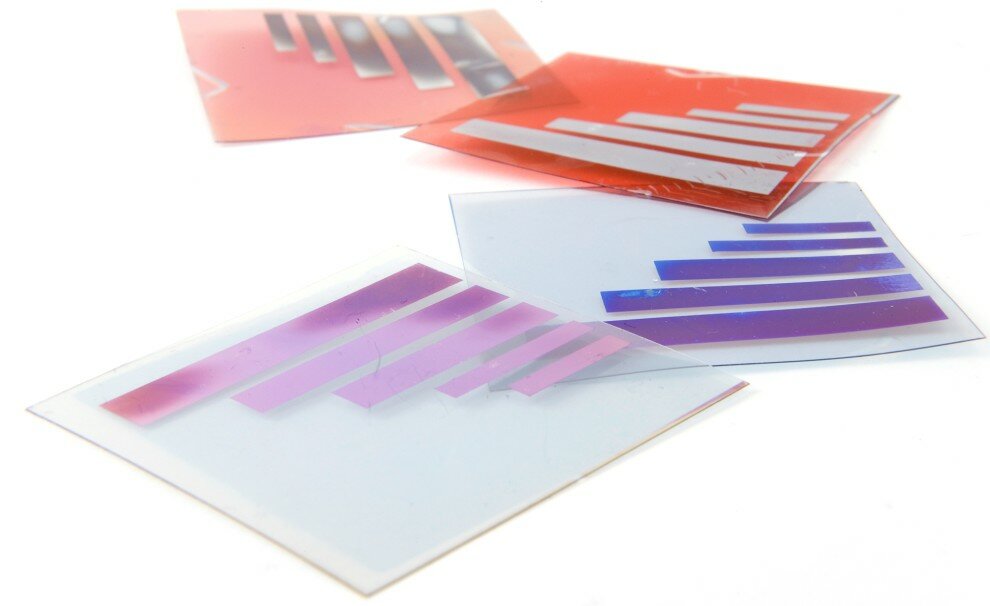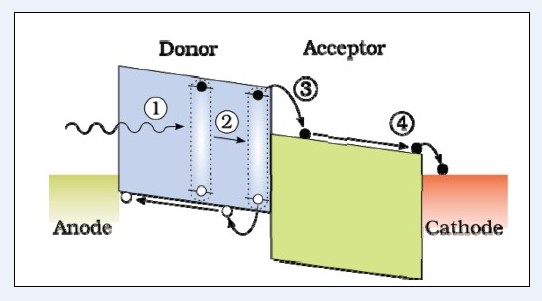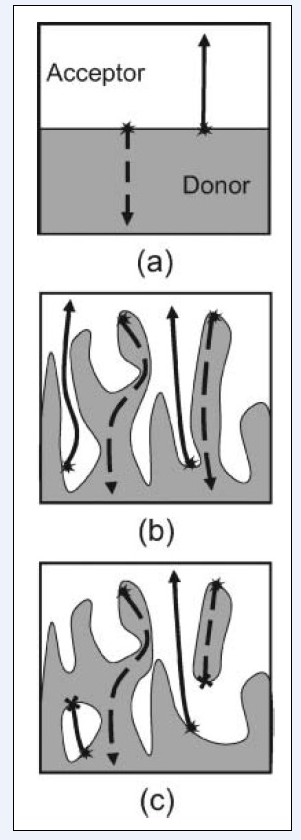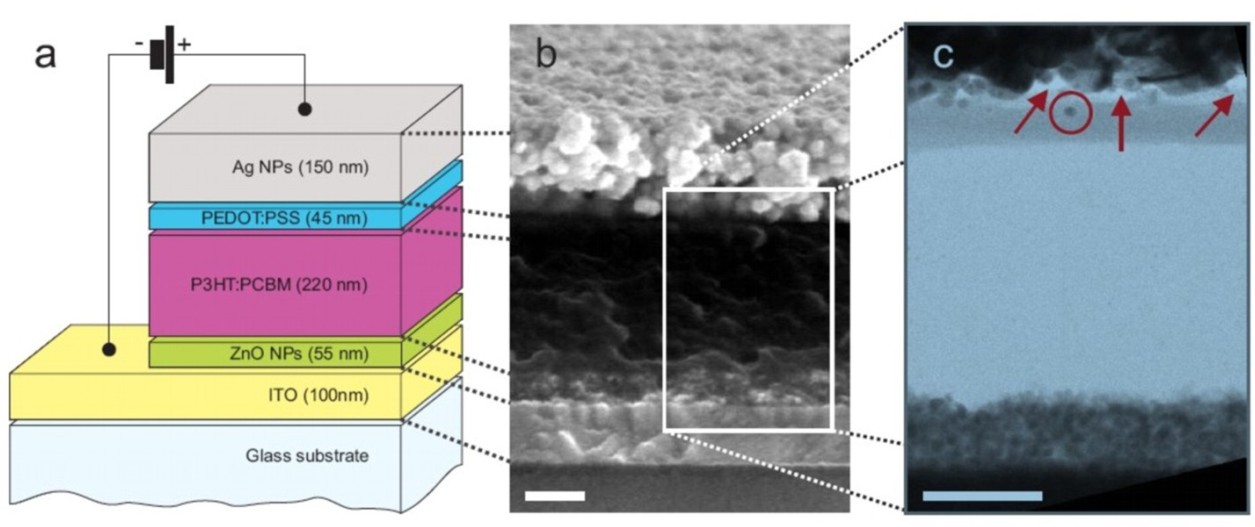
Organic solar cells
By Mieke Van BaveL, Tom Aernouts
Although progress is steady, organic solar cells are not (yet) ready for large-scale electricity production. Nevertheless, they are emerging in several niche applications, like on clothing, to power the batteries of mobile phones or mp3 players. In such applications, their mechanical flexibility, their low weight and cost, ease of processing and their operability in varying lighting situations are of key importance, largely compensating the low efficiency and stability.
What Is Organic Solar Cell?
During the last decade, there is a growing interest in the field of organic Photovoltaics (PV), where solar cells have organic semiconducting materials as the photo-active layer. It is unlikely that these organic solar cells will ever show superior performance and lifetime to Si- or GaAs-based cells. But the intriguing combination of low weight and cost, ease of processing and mechanical flexibility has raised expectations for a number of cost-sensitive solar cell applications. Part of the challenge of organic PV arises from its unique physics. Unlike inorganic solar cells, where photon absorption results in the creation of free electrons and holes, photon absorption in an organic semiconductor results in the creation of an exciton, or bound electron-hole pair. The key to efficient photocurrent generation is the presence of an interface between two organic semiconductors, called the Donor (D) and the Acceptor (A). This interface allows to dissociate excitons into free electrons and holes, which are then transported on the A and D materials, respectively, producing a photocurrent. Excitons are far less mobile than free charges, and exhibit a small diffusion length. The latter determines the fractions of excitons that reach the D/A interface. However, most organic materials possess high absorption coefficients, implying that the layer thicknesses can be kept thin yet still highly absorptive.
A Myriad of Materials and Architectures
Various classes of organic materials have been investigated through the years. Here, we focus our attention on two main classes: organic solar cells that are based on a heterojunction between (1) polymeric and (2) small molecular weight organic materials. The junctions of organic solar cells made from small molecules typically have a planar structure, commonly achieved by vacuum thermal evaporation or vapor phase deposition of the molecular components. The performance of such a molecular PV cell is dependent on material selection (such as phthalocyanines and subphthalocyanines), on the material growth technique and on the device architecture. As a result, there is a nearly infinite number of possibilities in overall device selection. The class of organic solar cells based on polymeric materials can be processed from solution owing to their solubility in various organic solvents. The most efficient polymer-based devices fabricated to date have been based upon the bulk heterojunction approach, whereby the two active components of the solar cell are blended together in solution and processed simultaneously. The real advantage of these bulk heterojunction devices is the ability to process the composite active layer from solution in a single step, by using a variety of techniques that range from spin coating to inkjet printing and spray coating. Their disadvantage is a relative short lifetime: under long-term operation, all solar cells based on an intimate mixing of organic semiconductors deteriorate. This is due to segregation of the mixture whereby the compounds tend to separate into different phases and consequently reduce the efficient conversion of light into electricity.
Regardless of the method of preparation, one feature that extends across both classes of organic solar cells is the almost ubiquitous use of fullerenes as the electron-accepting component. The high electron affinity and superior ability to transport charge make fullerenes the best acceptor component currently available for these devices.
Organic Solar Cells: Where Are We Today?
The efficiency of organic solar cells has increased steadily in the last decade. The workhorse material system studied by many groups in the field of organic photovoltaics is currently represented by bulk-heterojunction solar cells based on poly (3-hexylthiophene) (P3HT) and the fullerene derivative PCBM, with efficiencies in the range of 3-5%, and with lifetimes measured in days or months. This materials system has enabled a dramatic improvement in the fundamental understanding, device construction and processing of the active layer. In combination with recent developments of new types of donor materials like polyfluorenes, record efficiencies of organic PV have rapidly approached 7% in the last two years.

Figure 1. Energy diagram of an organic solar cell with a donor-acceptor interface. The four subsequent processes to generate photocurrent are (1) absorption of an incident photon to create an exciton, (2) diffusion of an exciton toward the donor-acceptor interface, (3) breaking-up of the exciton at the interface by charge transfer of an electron in the acceptor and hole in the donor, and (4) transport of charges to and collection at the contacts. (Source: IMEC)
Towards 10% Efficiency Organic Solar Cells
On paper, we can design an organic solar cell with an efficiency of 15%. But we haven’t yet found the right organic material that we need for that cell. Meanwhile, we can make further improvements that are needed to make OPV an economically viable technology. Understanding and combating the various loss mechanisms that occur in the processes from optical excitation to charge collection should lead to efficiencies in the order of 10% in the near future.
Absorption
A first route to follow is to improve the absorption spectrum of the photoactive layer, which, to a large extent, determines its potential for harvesting incident solar radiation. Organic semiconductors, unlike their crystalline inorganic counterparts, do not absorb a continuous spectrum of photons but have well-defined electronic transitions. A closer investigation learns that the absorption spectra are very much dependent on the morphological and electrical characteristics of the organic layers. E.g., crystalline films have a wider absorption window compared with amorphous films, and are excellent candidates for bulk heterojunction single-junction cells. An alternative solution to broaden the spectral absorption is to combine different organic material systems. IMEC has proven this principle by processing different photo-active layers on top of each other in a multijunction configuration. Using a solution processed ZnO nanoparticle interlayer in between a polymeric photo-active layer and a small molecule evaporated photo-active layer resulted in a series connected tandem device with increased open-circuit voltage. With such a multijunction concept, conversion efficiencies of 15% should come within reach.

Figure 2. Representation of donor/acceptor interface architecture possibilities: (a) a planar heterojunction, formed between thin films of donor and acceptor materials; (b) an optimal bulk heterojunction, where there is complete phase separation of donor to one side and acceptor to the other side of the device structure; and (c) a non-ideal bulk heterojunction, where isolated regions of donor and/or acceptor phases prevent the collection of photogenerated charges. Dashed (solid) lines correspond to hole (electron) transport, and the arrow ("x") represents continuing (terminated) charge carrier flow. (Source: IMEC)
Exciton Diffusion
The relative low exciton diffusion length, i.e., a measure for the fraction of excitons that reach the D/A interface, puts further constraints on the organic solar cells efficiency. The most explored approach to optimization to date is to reduce the average distance between D/A interfaces by forming a bulk heterojunction, as explained in a previous section. Next to this, theoretical calculations have shown that tuning the thicknesses of the different layers can enhance the percentage of excitons that reach a dissociation center. IMEC recently investigated a third route, which consists of converting singlet excitons into triplet excitons, which have orders-of-magnitude longer lifetime, favoring a longer exciton diffusion length. Triplet excitons are not generated directly by optical excitation of fluorescent hosts, but by adding small quantities of well-chosen phosphorent dopants, singlets could efficiently be converted into triplets in conventional fluorescent donor material.
Charge Transfer and Collection
When it comes to exciton dissociation at the D/A interface, the donor and acceptor should have ideal electronic relationships for an optimal efficiency. This can be translated in terms of the Highest Occupied Molecular Orbital (HOMO) level of the donor (HOMOD) and the Lowest Unoccupied Molecular Orbital (LUMOA) level of the acceptor: the limiting value of the open-circuit voltage for an exciton pair that still allows complete exciton dissociation into free carriers is given by the difference between the HOMOD and LUMOA, minus at least the binding energy of the electron-hole pair at the D/A interface. Estimations for that latter term range from 0.3 to 0.8eV, and this uncertainty is to a large extent responsible for the large variety of estimations of the ultimate efficiency of single-junction organic cells, ranging from 8% to 15%. Furthermore, for identical material systems, there are differences in open-circuit voltage between a planar heterojunction and a bulk heterojunction device, as a result of the distribution of exciton dissociation centers in the layer structure. Since fullerenes are well accepted as acceptor material, a strong focus is put on the synthesis and evaluation of new donor materials that have an optimal HOMOD.
Paving the Way to Commercialization
To realize commercial applications of organic solar cells, the challenge is in developing large-area modules with long operational lifetimes, high production yields, low production costs, and high efficiency.

Figure 3. (a) Schematic build-up of the organic solar cell, (b) SEM and (c) FIB/TEM cross sections of the polymer solar cell with a spray coated Ag top contact (Source: IMEC)
Towards Increased Efficiency
The recent increases in efficiency along with the growing research community in organic solar cells indicate that commercially viable efficiencies of 10% seem within reach.
Enhancing the Stability
Device stability remains a very important issue and it is estimated that lifetimes of at least 5 years are necessary for practical devices. Increasing the stability, which today is measured in days or months, requires encapsulation processes since organic semiconductors are sensitive to heat-induced degradation in the presence of air and moisture. In addition, in polymeric solar cells, the deterioration of the organic semiconductors is related to the mobility of the organic polymer. IMEC has shown that fixation of the nanomorphology of the polymers could result in an enhanced operational lifetime. In collaboration with its associated laboratory IMOMEC (Hasselt University), IMEC has been able to stabilize the nanomorphology of the active layers making if far more robust to phase segregation under prolonged operation. The resulting cells have an efficiency that is comparable to state-of-the-art organic solar cells, but they last at least 10 times longer.
Low-cost, High Throughput Deposition Methods
Large-scale production of organic solar cells also requires a cheap, reliable, high-throughput and fast process to produce organic solar cells. Among the methods for depositing a bulk heterojunction layer, currently the most efficient solar cells, spin coating is the most commonly used technique. Although it is a highly reliable and reproducible method, it is limited to small areas and is not scalable to roll-to-roll production?a vital step en route towards mass production. Besides, there is a considerable waste of solvents and polymers during processing. To realize large-area coverage for practical solar cells, alternative deposition techniques have been utilized, such as inkjet and screen printing, and doctor blading. Recently, spray coating has been introduced as a valid alternative, as it holds the promise to be a cheap, efficient, high-throughput large-area deposition technique. Spray coating is well established in graphic arts, industrial coatings, and painting. It ensures an ideal coating on a variety of surfaces with different morphologies and is often used for in-line production. Unlike using spin coating, the fluid waste is reduced to minimal quantities, and the deposition can be easily patterned by simple shadow masking. IMEC has recently demonstrated a fully solution-processed organic solar cell with a spray-coated active layer and a metal top contact spray-coated on top. The resulting cell shows power conversion efficiencies above 3%, a performance comparable to organic solar cells produced by spin coating of the organic layer and vacuum evaporation of the top contact metal. This is an important step towards producing organic solar cells with cheap and large-area processes.
Potential beyond Large-scale Electricity Production
Although organic solar cells will probably never be able to compete with Si or GaAs in terms of performance and lifetime, they are market as a true-low-cost technology. The possibility to use cheap deposition techniques in combination with the ability to use little active material contribute to this advantage. But they have other trumps, like their mechanical flexibility, their low weight, ease of processing and operability in varying lighting situations. Therefore, we expect to see them emerging in all kinds of niche applications: organic solar cells will be incorporated in clothing, curtains, wall coverings where they, in turn, can power mobile phones or displays or other organic electronic devices. In such applications, the limited lifetime and low efficiency of organic solar cells may prove acceptable.
Future Prospect
Organic solar cells belong to the class of photovoltaic cells known as excitonic solar cells. A deeper understanding of their unique physics--from photon absorption to photocurrent generation--as allowed improving their energy conversion efficiency to close to 7% and will soon lead to champion 10% organic solar cells. Improvements included broadening the spectral absorption of the organic materials, enhancing the exciton diffusion length and identifying high-performance donor/acceptor combinations. Besides enhancing the solar cells efficiency, different routes to a prolonged stability have been proposed, such as encapsulating the solar cells and stabilizing the nanomorphology of the polymers. Low-cost, high-throughput deposition techniques have been introduced, like spray coating for the creation of bulk heterojunction organic solar cells.
All these improvements will eventually enhance the potential uptake of the technology by industry. Although they will never defeat inorganic solar cells like Si in terms of performance and lifetime, their low cost is an important triumph for market competitiveness. Meanwhile, new market opportunities besides large-scale electricity production are emerging, like the incorporation of organic solar cells in flexible substrates to power other electronic devices. In such applications, their low cost, but even so their low weight, ease of processing and their operability in varying lighting situations can compensate for lower efficiency and shorter lifetime.
Mieke Van Bavel received the Ph.D. in Physics from the Katholieke Universiteit Leuven, Belgium, in 1995. She joined IMEC (http://www.imec.be/) as a scientific editor in 2001.
Tom Aernouts received the Ph.D. in Physics from the Katholieke Universiteit Leuven, Belgium, in 2006. Since then, he has been the team leader of Organic Photovoltaics at IMEC .
For more information, please send your e-mails to pved@infothe.com.
ⓒ www.interpv.net All rights reserved |



